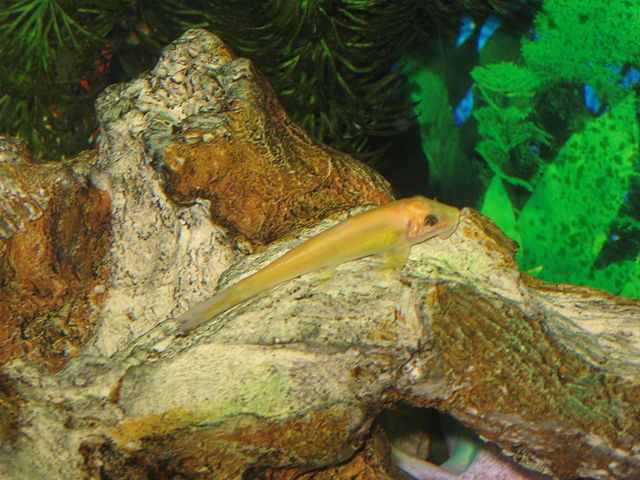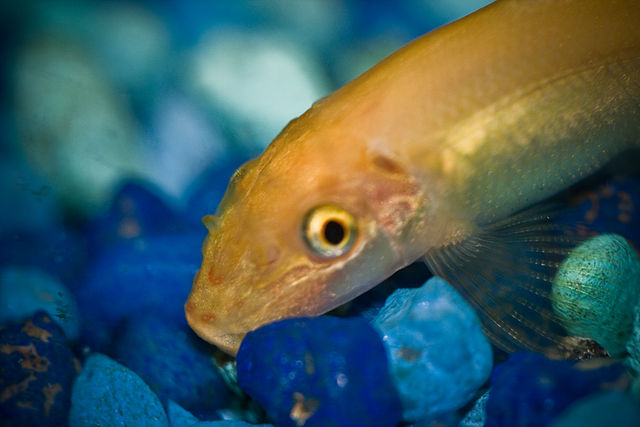Chinese Algae Eaters are very popular little freshwater fish.
They are also called Indian algae eaters, sucker loach, sucker fish, sucking catfish, Siamese algae eater, Siamese headbreather, honey sucker, biforated carp, and golden algae eater. Whew!
They are often confused with other similar-looking or similar-named fish, but the easiest way to find them is by their scientific name, Gyrinocheilos aymonieri.

They are readily available at most pet stores, fairly inexpensive, and easy to care for, but are they right for your tank?
Contents
Chinese Algae Eater Origin and Appearance
As their name implies, this fish hails originally from Asia and is found in large areas of Southeast Asia and China.
In its native country, it is often used as fish food! They are part of the fish family that includes carp, so predictably they tend to stay towards the bottom of the tank.
They start out small, usually only two inches, but Chinese algae eaters can grow up to 11 inches at full maturity in the wild.
Captive fish tend not to get bigger than 5 inches. They are not a particularly flashy fish, slender in body and golden-brown with a darker stripe or spots.
There are some color morphs available in pet stores, if you are looking for a more unusual fish for your tank.
They have a round mouth which forms a disk that allows them to suck to surfaces and keep grip even in a fast-moving current.
Lifespan
With proper care, Chinese algae eaters can live 5-10 years. There is little difference in appearance between males and females, so they can be a challenge to determine the sex of.
They are also difficult to breed in home aquariums, so it is unlikely you’ll see babies, even when kept in a group.
Though most of these fish come from the wild instead of breeders, they are categorized as less concerning, so owning one should not negatively impact the environment.

Price
Chinese algae eaters are pretty inexpensive when bought from local speciality and pet stores.
They range from a few dollars for common species, while more exotic and larger Chinese algae eaters will go beyond the cost of $10 to about $20 or $30 USD – all depending.
Health Concerns
Because Chinese algae eaters don’t have scales on their bellies, they are more susceptible to disease than other species, and many times, they are also sensitive to the medication used to treat diseases.
If you have an established tank and one of your other fish become sick, it may be best to also quarantine the Chinese algae eater in order to protect it.
Despite this, they are resilient fish, so as long as you catch the threat early, you should be able to help your fish recover.
The less stress in their environment, the less likely they are to become sick. Keeping them in small groups and giving them plenty of places to explore is the best way to reduce the stress.
One of the most common fish diseases is ich, which is a parasite that causes white spotting. Treat the water with ich medication and your fish should recover without problem.
Chinese Algae Eater Care
Tank Requirements
Chinese algae eaters are very active fish, and will need a tank size to reflect this.
A young algae eater may be fine in a minimum tank size of 30 gallons, but as they grow, they will need a bigger tank.
Adult algae eaters should be in a tank of at least 55 gallons, especially if you’re going to house them in a group of other algae eaters.
These fish are also prone to jumping, so make sure your tank has a secure lid or you may find your fish on the ground!
Because algae eaters need very clear water, it’s best to have an undergravel filter. This will help reduce the amount of waste, and keep the oxygen levels high.
They don’t need a lot of decorations and plants, but do like to have places to hide and explore. They especially enjoy larger smooth rocks scattered about the substrate to latch onto and eat algae from.
Whatever décor you have in your tank, make sure it has surfaces that allow for algae growth so that your fish has plenty to eat.
Water Requirements
As with all fish tanks, the water, substrate, and decorations should be cycled in the tank before fish are introduced.
Algae eaters are fairly hardy, but they do need the water to be very clean in order to thrive and stay healthy.
They need only a normal amount of lighting, but since they graze on algae, it’s best to place the tank where it gets a moderate amount of sunlight to promote algae growth.
The tank should be kept at between 77 and 82 degrees Fahrenheit with a pH of 6.0 to 8.0.
This fish tends to stay near the bottom and sides of the tank, so it does not matter much how strong the current is.
In the wild, they often live in rivers with fast-moving currents, so choose water that will be best for the other fish in your tank if you intend to host more than just the algae eaters.
Tank Set-Up
If you already have fish in your tank and want to add an algae eater, the best way to do so is in a quarantine tank first.
This not only keeps a potentially sick fish away from the others, but it allows the new fish to get used to the water and food you are providing, reducing stress.
Before you remove your algae eater from quarantine, make sure that the tank has plenty of places for the algae eater to hide.
Rearrange the current layout of your tank to distract the existing fish and remove any established territories. Feed your current fish right before introducing the new one, which will make them less aggressive.
It is also better to introduce more than one new fish at once, as it reduces the chances of one new fish being singled out and aggravated.
And, as always, make sure you water is clean and appropriately balanced to reduce stress in all of the fish.
If you introduce them last to the tank, they are less likely to be aggressive towards the fish already there. It’s best to start with young algae eaters, as they are more prone to just forage for food and leave their tankmates alone as they get established.
Chinese Algae Eater Food
Young Chinese algae eaters are voracious eaters and do a good job of cleaning out the algae within the tank, but as they get older, they get more territorial and eat the algae less. You can supplement their diet not only with the algae in the tank, but algae wafers.
As an adult matures, it may also need meatier foods, and if not provided, they may go after the slime coating of tank fish or small crustaceans.
Sometimes you can even feed them crushed lettuce or spinach, if there is not enough algae in your tank. They also may enjoy shelled peas, cucumber, and chopped fruit.
Adult fish can eat live and flake foods to help curb their aggression towards tankmates, such as bloodworms and brine shrimp.
In general, offer regular food daily (if there is algae in your tank, this is the regular food!), and supplement with an algae wafer every other day or so. As it matures, offer flake and live food occasionally.
Here’s a video showing how a Chinese algae eater feeds.
Tank Maintenance
Once a tank is set up and the fish are happy, water changes are the best way to maintain a healthy tank.
Smaller tanks require more frequent water changes because toxins such as ammonia and nitrates build up more quickly compared to larger tanks. Regular water changes and good filters are more important the smaller the tank.
Replace 25-50% of the tank water once a month. It may also be a good idea during cleanings to vacuum the substrate to help keep the water clean and balanced. You can use a magnet scraper on the sides of the tank if there is a lot of build-up.
Disease can be introduced to the tank when you add anything that has not been properly cleaned or quarantined, including live rock, corals, and fish.
The best prevention is proper care and cleaning of anything new going into the tank, as well as making sure that you provide quality food, good water, and proper tank mates.
Algae eaters are very sensitive to water changes, so make sure you keep the water as stable and clean as possible to prevent disease.
Chinese Algae Eater Tankmates
Chinese algae eaters can be somewhat aggressive, so it’s best to select tankmates with care.
They get along well with members of their own species, and can be kept in groups of five or more. They are safe to have with plants, shrimps, crabs, and snails, but should be monitored with all other fish.

They will sometimes try to suck on slow-moving fish and could injure them. They are best paired with fast-moving, active, and robust fish such as cyprinids or characids, and also do fine with African Cichlids.
Keeping the algae eaters in a small group of their own species will help dissuade them from being aggressive towards other fish too.
These fun and hardy fish can be a great tool to keep up your tank when they are young, but can become challenging as they mature.
Keep your fish happy with algae pellets, lots of places to explore, and good clean water, and they can be your lasting companions for years to come.
Do you own any Chinese Algae Eaters?



